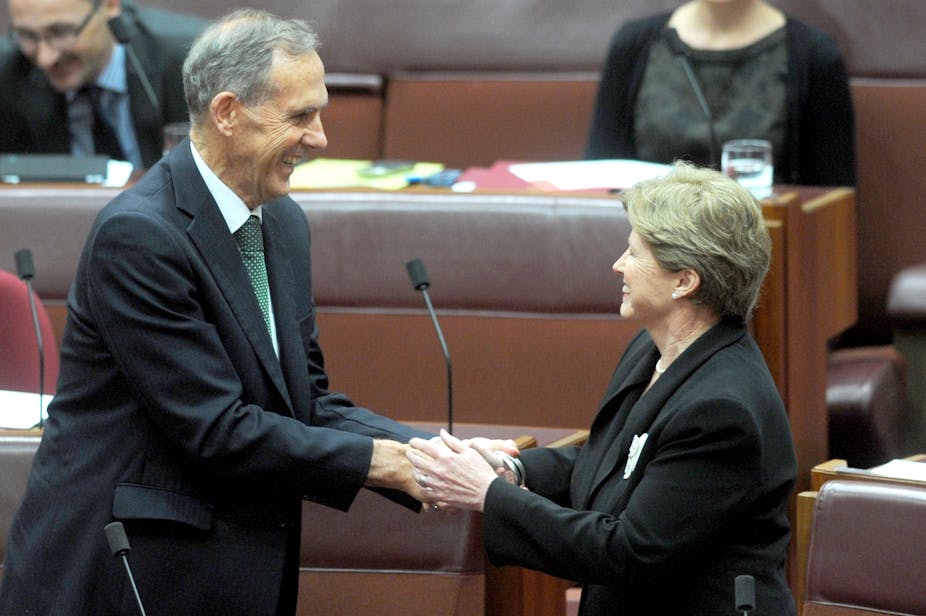Australia has a long record of charismatic political leaders and Bob Brown is perhaps the most notable recent example, but unlike other leaders of this style he has demonstrated remarkable political skill.
The concept of charismatic leadership was first defined by Max Weber as “that resting on devotion to the exceptional sanctity, heroism or exemplary character of an individual person.”
Brown exemplified a broad style of charismatic leadership; by contrast, Pauline Hanson, adhered to the narrow. Brown presided over the steady emergence of the Australian Greens as an effective national political party, Hanson presided over (or at times merely observed) the meteoric rise and rapid fall of One Nation.
While the Greens’ current electoral success owes something to Labor’s trend to the right, it has independently succeeded in carving out its own durable niche to the left of the Labor, unlike so many previous attempts.
A brief history of Australian charisma
The phenomenon of charismatic leadership is the result of the interaction of personal qualities and social circumstances. Notorious party-changer and Australia’s seventh prime minister Billy Hughes, former NSW premier Jack Lang and One Nation leader Pauline Hanson all surfed waves of social conflict around class and national identity.
All were charismatic leaders, but all eventually deluded even themselves. Their appeal was as much directed against their enemies as it was towards supporters.
In a deeply divided nation such as Australia during World War I and the Great Depression, this strategy worked for a time for Hughes and even Lang. Both leaders were able to form electoral majorities around imperial loyalty (for Hughes) and the defence of working-class living standards (for Lang).
Both targeted enemies: Catholic Bishop Daniel Mannix, Bolsheviks and Sinn Feiners for Hughes and the “money-power” for Lang. In the end, however, both Hughes and Lang took their rhetoric too far and repelled voters and their political allies.
From the fringes to the mainstream
Pauline Hanson, like Bob Brown, faced a difficult challenge. Both the Greens and One Nation were parties of a minority (much more so than the parties of Hughes or Lang) but some of their beliefs, ethnocentric nationalism for One Nation and environmental protection for the Greens, appealed to many more voters than just their true believers.
Pauline Hanson, however, forgot the first lesson of radical political success; that a radical party needs a “conservative” or at least reassuring leader. She thrived on polarisation and delighted in martyrdom status. Rather like would-be Republican Vice President Sarah Palin, she wore out her welcome, even among many initially sympathetic to her message.
In Europe, some former far-right fringe parties have made the transition to mainstream politics, but others such as the British National Party have failed to adapt, just as One Nation failed. Bob Katter seeks to appeal to a constituency once attracted to Hansonism but unlike Hanson he has eschewed an aggressive and polarising style.
In this respect he is following in Bob Brown’s footsteps. If Katter appeals to an imagined Australian nation, Brown appeals to a human community. Both have largely steered clear of identifying a class of enemies.
Minor challenges, a strong future
Once a minor party has managed an electoral breakthrough it faces a new set of challenges. It has to remain united in the difficult process of political compromise. As a minority it has to persuade voters that it can deliver, resist its themes being co-opted by the major parties and also reassure its activists that it has not surrendered its identity.
Charismatic leadership can be particularly useful in the latter task. A party’s true believers have to be reassured that they are not forgotten. The task of participation in government is necessarily once of compromise and frustration. Bob Brown’s personal appeal has been vital in insulating the Greens from their radical critics.
Bob Brown’s charismatic appeal has aided his appeal to both green activists and more moderate voters.
New leader Christine Milne will have to continue this balancing act, but it is likely that the political landscape will continue to favour the party.
Labor in government will continue to work hard to repel many voters on the left, while the likely post-2013 scenario of an Abbott government and a traumatised and bewildered ALP can only render the Greens even more attractive to first-time voters on the left.

